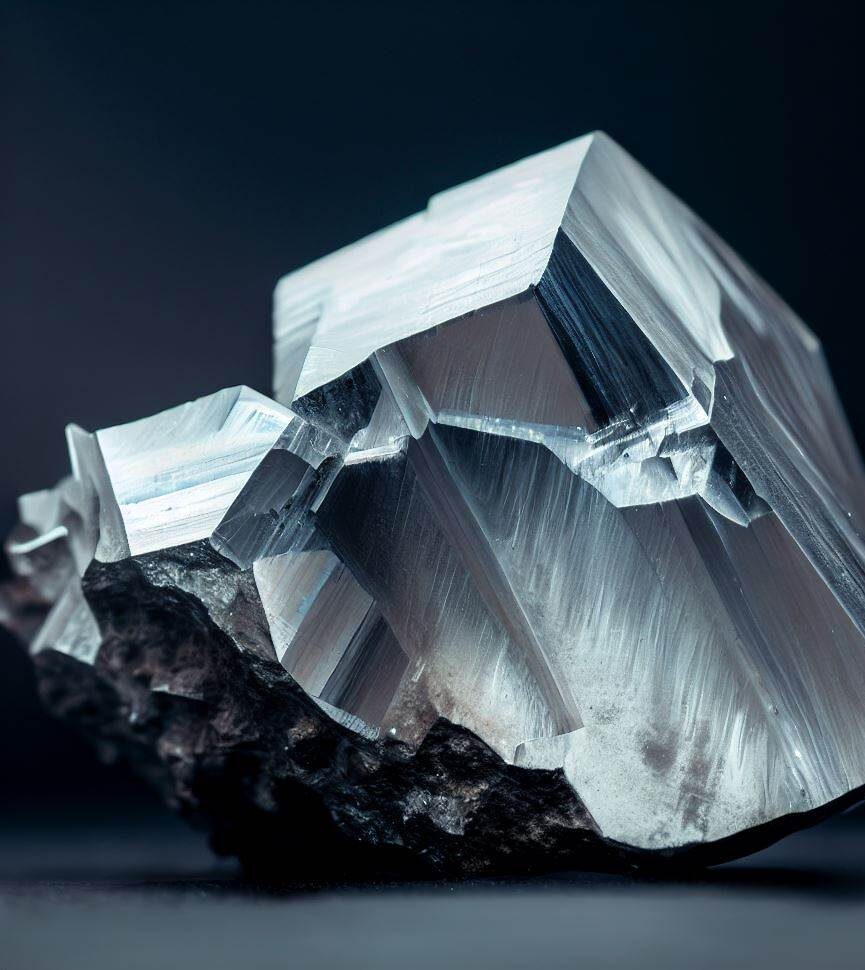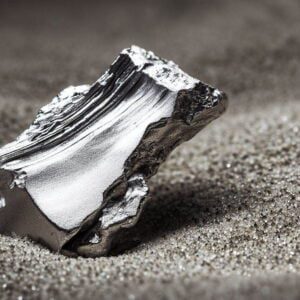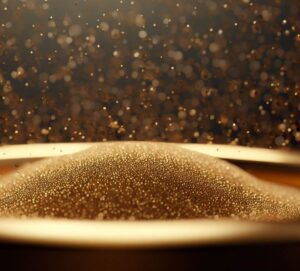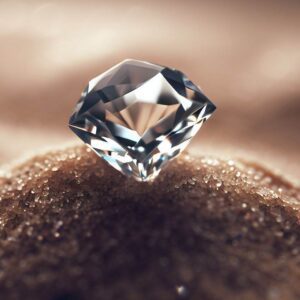Silver
Silver is a soft, shiny, white, and lustrous transition metal. It is one of the seven metals known in antiquity.
Silver in Jewelry
Silver is a soft, shiny, white, and lustrous transition metal. It is one of the seven metals known in antiquity and is found in nature as minerals such as argentite and galena.
Silver is an excellent conductor of electricity and heat and is resistant to oxidation and corrosion. It is more ductile and malleable than gold and is commonly used in the production of jewelry, cutlery, coins, and other decorative and functional objects.
Silver is also used in the manufacturing of chemicals, mirrors, photography, and other industrial purposes. Due to its beauty, durability, and workability, silver is a valuable and versatile metal that has been used for thousands of years.
Silver is a metal that has been used in jewelry since ancient times because of its beauty, luster, and durability. Some aspects of using silver in jewelry are:
- Silver is a noble metal, which means it does not easily oxidize or corrode in the environment. This makes silver jewelry retain its appearance and value for a long time.
- Silver is malleable and ductile, allowing it to be molded and stretched into different shapes and designs. This allows for a wide variety of silver jewelry styles, from classic to modern.
- Silver is antibacterial, inhibiting the growth of harmful microorganisms. This makes silver jewelry hypoallergenic and beneficial for skin health.
- Silver is a conductor, which means it can transmit heat and electricity. This allows silver jewelry to adapt to body temperature and feel comfortable to the touch.
- Silver is affordable, making it a lower-priced option compared to other precious metals like gold or platinum. This makes silver jewelry accessible to many consumers and a popular choice for gifts.
History of Silver
Silver is a precious metal that has been used since antiquity as money, jewelry, and material for various applications. Some aspects of the history of silver include:
- Silver is mentioned in the book of Genesis, and remnants of its separation from lead have been found in Asia Minor and islands in the Aegean Sea, dating back to around 4000 BC.
- Silver was one of the seven metals known to ancient civilizations and was used to mint coins in many civilizations, including Greece, Rome, Persia, India, and China.
- Silver was highly sought after by Spanish conquistadors in the Americas, where large deposits were found in Mexico, Peru, and Bolivia. The exploitation of silver generated great wealth for Spain and facilitated global trade between Europe, Asia, and America.
- Silver played a significant role in the development of photography, electricity, medicine, and chemistry, thanks to its optical, conducting, antibacterial, and catalytic properties.
- Silver has experienced fluctuations in its value throughout history, depending on supply, demand, speculation, and political and economic events. Currently, silver is primarily used for industrial, technological, and ornamental purposes.
How to Choose Silver for Jewelry?
When choosing silver for jewelry, it is important to consider certain factors to ensure you get a quality material. Here are some aspects to consider when selecting silver for jewelry:
Silver Purity
Silver used in jewelry is usually alloyed with other metals to enhance its durability. Silver purity is expressed in millesimal fineness, and the most common sterling silver is 925, which means it contains 925 parts of pure silver per 1000 parts of metal. The "925" mark indicates genuine silver. It is recommended for its strength and luster.
Quality of Finish
Observe the quality of the finish on the silver jewelry. It should have a shiny and smooth appearance, without visible scratches or irregularities. Also, check the details and precision of the designs to ensure the jewelry has been crafted with care.
Brand or Authenticity Mark
Look for a brand or authenticity mark on the silver jewelry. This may include the "925" mark, the manufacturer's name, or the country of origin. These marks provide confidence about the authenticity and quality of the metal used.
Reaction to Magnet
Genuine silver is not magnetic, so if you bring a magnet close to the jewelry and it is attracted, it is likely not authentic silver. However, keep in mind that some closures or parts of the jewelry may contain magnetic metals, so it's best to perform this test on a non-magnetic part of the piece.
Weight and Density
Silver is a dense metal, so genuine silver jewelry tends to be heavier compared to plated or fake silver pieces. If a piece feels light or too light for its size, it may not be authentic silver.
Seller's Reputation: Buy silver jewelry from trusted and reputable establishments. Research the store or jeweler, check customer reviews, and look for certifications that support the authenticity of the silver used.
Design and Style
Choose a piece of jewelry that reflects the personality and taste of the wearer, as well as suits the occasion and outfit. There is a wide variety of silver jewelry designs and styles, ranging from classic and elegant to contemporary and bold.
Matching with the Outfit
Consider how the silver jewelry will complement the color and style of the outfit. Silver is a versatile metal that can harmonize with any color tone, but choose a design and size that complements and enhances the overall look.
Ultimately, the best way to ensure you are getting authentic and quality silver is to purchase from reliable and well-established sources in the jewelry industry.
Quality or Purity of Silver
The purity of silver is measured in terms of its fineness in an alloy. It is expressed in millesimal fineness, indicating the number of parts of pure silver per thousand parts of the alloy. Some aspects of silver purity include:
- Pure silver has a fineness of 1000 millesimal or 12 dineros. This means that out of every 1000 parts of the alloy, 1000 are pure silver. Pure silver is very soft and is not commonly used in jewelry.
- Sterling silver has a fineness of 925 millesimal or 11.1 dineros. This means that out of every 1000 parts of the alloy, 925 are pure silver, and the rest are other metals, such as copper or zinc. This is the most common silver used in jewelry and is known as sterling silver or 925 silver.
- Second-grade silver has a fineness of 800 millesimal or 9.6 dineros. This means that out of every 1000 parts of the alloy, 800 are pure silver, and the rest are other metals. This is the lower-quality silver used less in jewelry.
- Mexican silver has a fineness of 950 millesimal or 11.4 dineros. This means that out of every 1000 parts of the alloy, 950 are pure silver, and the rest are other metals, such as copper or tin. This is a finer silver than sterling and is used in silversmithing and silverware.
- British silver has a fineness of 958 millesimal or 11.5 dineros. This means that out of every 1000 parts of the alloy, 958 are pure silver, and the rest are other metals, such as copper. This is used for making cutlery and commemorative coins.
Colors of silver
Silver in jewelry can have different colors depending on the type of alloy used and the treatment applied to it. Some colors of silver in jewelry are:
- White Silver: This is the natural color of pure silver or sterling silver, which has a metallic shine and reflects light. It is the most common and versatile color in silver jewelry.
- Black Silver: This is the color silver acquires when it oxidizes or when a black rhodium plating is applied to it. It is an elegant and sophisticated color that contrasts with clear gemstones or golden metals.
- Gold-Plated Silver: This is the color silver acquires when it is coated with a layer of yellow or rose gold. It is a warm and luminous color that imitates the appearance of gold but at a more affordable price.
- Antique Silver: This is the color silver acquires when it undergoes a chemical or thermal treatment to give it an aged and worn-out look. It is a color that highlights the details and textures of silver jewelry.
Silver Alloys
Silver alloys in jewelry are mixtures of silver with other metals to enhance their physical and aesthetic properties. Some types of silver alloys used in jewelry include:
Sterling Silver
It is an alloy of 92.5% silver and 7.5% copper. It is used to make body jewelry, belt buckles, cufflinks, bracelets, necklaces, and rings.
Vermeil
It is a sterling silver alloy coated with gold. It is used to give a more luxurious and durable appearance to silver jewelry.
Mexican Silver
It is an alloy of 95% silver and 5% copper. It is used to make typical Mexican jewelry, such as earrings, pendants, and brooches.
British Silver
It is an alloy of 95.8% silver and 4.2% copper. It is used to make silverware and commemorative coins.
Manufacturing Silver for Jewelry
The manufacturing of silver for jewelry involves the following steps:
- Metal and Alloy Selection: Choose the silver and the other metal with which it will be mixed, usually copper, to obtain a more resistant and malleable alloy than pure silver.
- Casting: Heat the metal in a crucible until it melts and then pour it into a mold to shape it into a bar.
- Rolling: Pass the bar through a press or rolling machine that flattens it into a sheet of the desired thickness for the ring.
- Piercing: Cut the sheet with a jewelry saw following the design you want to use for the ring.
- Polishing: Clean and polish the piece with a polishing machine or a soft cloth to give it a shine and remove imperfections.
- Accessories: Add other elements to the piece, such as stones, pearls, enamels, or engravings, according to the taste and creativity of the jeweler.
Value and Investment
Silver is a precious metal used as an investment, a form of money, and material for various industrial, medical, and artistic applications. Investing in silver has its advantages and disadvantages, depending on the investor's objectives, risk profile, and expectations. Some aspects to consider are:
- Silver is a safe-haven investment that can protect purchasing power against inflation and economic crises. Silver tends to rise in price during times of market uncertainty or weakness, as was observed at the beginning of the COVID-19 pandemic.
- Silver has a growing demand for industrial, technological, and medical uses, which can drive its long-term value. Silver is used in the manufacturing of solar panels, electronic devices, chemical catalysts, biocides, and jewelry, among other products.
- Silver has limited supply that cannot easily meet global demand. Most silver is extracted as a byproduct of other metals, such as copper, gold, or zinc, making its production dependent on the profitability of these sectors. Additionally, silver is consumed and lost in many industrial processes, reducing its availability
- Silver is a volatile metal that can experience significant price fluctuations in short periods. This is due to silver having a relatively small and liquid market, which can be influenced by speculative, political, or environmental factors. Volatility can offer profit opportunities but also entails higher risk.
- Silver has storage costs that can reduce the investment's profitability. If you choose to buy physical silver, such as bars or coins, you need to consider the space, security, and insurance required for storage. If you opt for buying silver through financial instruments like exchange-traded funds (ETFs) or contracts for difference (CFDs), you should consider commissions, taxes, and trading margins.
Silver Extraction
The process of extracting silver from mines depends on the type of ore containing the metal and the methods used to separate and purify it.
Some of the most common minerals containing silver include argentite (Ag2S), chlorargyrite (AgCl), and galena (a lead mineral that often contains significant amounts of silver). Some general steps followed to extract silver from mines are as follows:
- Preparation and blasting of the area where the ore is found.
- Loading and transporting the ore to a storage or crusher.
- Reducing the size of the ore and screening it to separate different components.
- Grinding the ore and mixing it with water and cyanide to form a pulp or slurry.
- Floating the pulp in special cells where silver adheres to the foam and separates from the earth and stone.
- Collecting the foam with silver and compacting it into burlap sacks using pressure.
- Melting the anodic silver sludge in ovens with diesel or petrolatum.
- Refining silver through chemical and electrical processes to obtain silver crystals or granules.
- Melting the silver granules again and depositing them onto rotating plates.
These steps may vary depending on the type and quality of the ore, as well as the conditions and resources available at each mine.
Tools for Silver Extraction
Silver is typically extracted through more complex mining processes, such as underground or open-pit mining. Here are some utensils and tools used in silver mining:
- Drills: Used to bore holes into the rock and allow the insertion of explosives for controlled blasting.
- Explosives: Employed to fragment the rock and allow for mineral extraction, including silver.
- Shovels and loaders: These machines are used to load the extracted ore into trucks or wagons for transportation.
- Drums or wagons: Used to transport the ore from the mine to the processing plant.
- Crushing equipment: To reduce the size of the extracted ore into smaller and manageable particles.
- Leaching tanks: Leaching is a chemical process used to extract silver from crushed rocks by applying chemical solutions that dissolve valuable minerals.
- Separation equipment: Used to separate silver from other impurities and minerals.
- Smelting furnaces: To melt the separated silver and obtain bars or ingots of pure silver.
- Safety equipment: Mining and mineral processing are hazardous activities, so appropriate safety equipment is required to protect workers.
It is essential to note that silver mining is a complex activity that requires specialized equipment and technical knowledge. Additionally, like with gold mining, silver extraction must be done in compliance with local regulations and laws, taking measures to protect the environment and workers' safety.
Raw Silver
Raw silver, as found in nature before undergoing refining processes, is referred to as "silver ore." Silver ore is a combination of silver with other minerals and compounds found in natural deposits, such as veins, lodes, or deposits.
There are different types of silver ores, and some of the most common ones include:
- Argentite: This is the most common silver ore and consists mainly of silver sulfide (Ag2S).
- Silver-bearing galena: A mixture of silver sulfide and lead sulfide (PbS).
- Pyrargyrite: Composed mainly of antimony, sulfur, and silver (Ag3SbS3).
- Proustite: Comprising silver sulfide and arsenic (Ag3AsS3).
- Cerargyrite: Also known as silver chloride, it is formed by the oxidation of other silver minerals.
It is important to mention that, in its natural form, silver ores contain impurities and other mineral combinations. To obtain pure and commercially usable silver, the silver ore must undergo extraction and refining processes in mining processing plants. These processes include crushing, grinding, leaching, smelting, and chemical refining to obtain silver in the form of bars or high-purity commercial products.


Sandra Sanchez
Sandra is passionate about jewelry and interior design. She graduated in interior design from Universidad Taller 5 in Colombia and has completed several courses and postgraduate studies in Jewelry in Barcelona and Madrid, Spain. She combines her work as a jeweler and interior designer with teaching.


